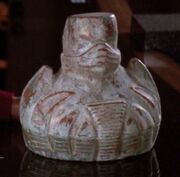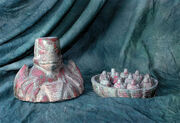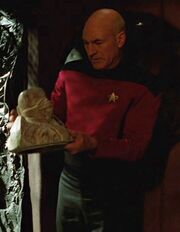(Spelling) |
Josiah Rowe (talk | contribs) (→Background information: removing speculation) |
||
| (51 intermediate revisions by 29 users not shown) | |||
| Line 1: | Line 1: | ||
| + | {{spoiler PIC}} |
||
| ⚫ | |||
| − | [[ |
+ | [[File:Kurlan naiskos.jpg|thumb|A Third Dynasty Kurlan ''naiskos'']] |
| ⚫ | |||
| ⚫ | A '''Kurlan naiskos''' was a ceramic figurine statue made by the [[Kurlan]] civilization |
||
| + | [[File:Picard and Kurlan naiskos.jpg|thumb|The Kurlan ''naiskos'' in 2371]] |
||
| ⚫ | A '''Kurlan ''naiskos''''' was a ceramic figurine [[statue]] made by the [[Kurlan]] civilization. A ''naiskos'' consisted of a large hollow body, of which the top half could be removed to reveal several smaller figurines inside, similar in shape to the original one. ''Naiskoi'' reflected Kurlan [[philosophy]] in the sense that they believed that an individual was actually a community of individuals, each with their own voice, their own desires and their own view of the world. Ornamentation on the surface of a ''naiskos'' indicated which dynasty of the Kurlan civilization it came from. Because the Kurlan civilization died out millennia prior to the [[24th century]], a complete or intact ''naiskos'' was extremely rare, making these highly valuable to collectors and [[archaeologist]]s. |
||
| − | [[ |
+ | In [[2369]], {{Captain}} [[Jean-Luc Picard]]'s former mentor, [[Professor]] [[Richard Galen]], gave him a complete and intact {{dis|Third Dynasty|Kurlan}} Kurlan ''naiskos'' manufactured by the [[Master of Tarquin Hill]]; the artifact was more than twelve thousand [[year]]s old. Picard was clearly moved by this gift. |
| + | Because the Master's work anticipated general design trends by approximately three hundred years, Picard's initial assessment was that it was Fifth Dynasty. However, after a prompt from Galen, he made a closer examination and correctly identified it. ({{TNG|The Chase}}) |
||
| − | The naiskos later adorned the [[captain's ready room]]. ({{TNG|Genesis|Bloodlines|Preemptive Strike}}; {{film|7}}) |
||
| + | The ''naiskos'' later adorned the [[captain's ready room]] until the {{USS|Enterprise|NCC-1701-D|-D}} crashed on [[Veridian III]] in [[2371]]. Picard found the top half of the artifact among the ship's wreckage, and after inspecting that it was intact, placed it back onto the floor. ({{TNG|Genesis|Bloodlines|Preemptive Strike}}; {{film|7}}) |
||
| − | :''One of the final scenes in {{film|7}} shows Picard finding his Kurlan naiskos among the wreckage of the {{USS|Enterprise|NCC-1701-D|-D}}. While the scene suggests that he leaves it behind, given that the naiskos is a priceless artifact and given Picard's previously established interest in archaeology, plus the personal nature of the gift, it seems likely that he would have returned to retrieve it from the ship at a later time, although this was not shown.'' |
||
| + | Picard's Kurlan ''naiskos'' was in his vault in the [[Starfleet Museum Quantum Archive|Quantum Archive]] at the [[Starfleet Archive Museum]]. ({{PIC|Remembrance}}) |
||
| ⚫ | |||
| + | |||
| + | ==Background information== |
||
| + | * The Kurlan ''naiskos'' prop was created by special effects artist [[Christopher Bergschneider]]. |
||
| + | * According to "Trill: Unjoined" in ''[[Worlds of Star Trek: Deep Space Nine, Volume Two]]'', Kurlan ''naiskos'' were a [[Trill]] art form. |
||
| + | * ''{{w|Naiskos}}'' is a real-world archaeological term meaning a small temple-like building (the word is the diminutive of Greek ''naos'', temple), or a container for small votive objects, such as the Kurlan naiskos. {{el|metmuseum.org/art/collection/search/242243}} |
||
| + | |||
| + | === External links === |
||
| + | * {{mbeta}} |
||
| + | * {{el|discuss.fleetworkshop.org/t/kurlan-naiskos-reference-photos-research/282|Kurlan naiskos research thread|discuss.fleetworkshop.org|FleetWorkshop.org}} |
||
| + | |||
| + | [[de:Kurlanischer Naiskos]] |
||
| ⚫ | |||
Revision as of 20:44, 24 January 2020
Template:Spoiler PIC

A Third Dynasty Kurlan naiskos

An opened Kurlan naiskos

The Kurlan naiskos in 2371
A Kurlan naiskos was a ceramic figurine statue made by the Kurlan civilization. A naiskos consisted of a large hollow body, of which the top half could be removed to reveal several smaller figurines inside, similar in shape to the original one. Naiskoi reflected Kurlan philosophy in the sense that they believed that an individual was actually a community of individuals, each with their own voice, their own desires and their own view of the world. Ornamentation on the surface of a naiskos indicated which dynasty of the Kurlan civilization it came from. Because the Kurlan civilization died out millennia prior to the 24th century, a complete or intact naiskos was extremely rare, making these highly valuable to collectors and archaeologists.
In 2369, Captain Jean-Luc Picard's former mentor, Professor Richard Galen, gave him a complete and intact Third Dynasty Kurlan naiskos manufactured by the Master of Tarquin Hill; the artifact was more than twelve thousand years old. Picard was clearly moved by this gift.
Because the Master's work anticipated general design trends by approximately three hundred years, Picard's initial assessment was that it was Fifth Dynasty. However, after a prompt from Galen, he made a closer examination and correctly identified it. (TNG: "The Chase")
The naiskos later adorned the captain's ready room until the USS Enterprise-D crashed on Veridian III in 2371. Picard found the top half of the artifact among the ship's wreckage, and after inspecting that it was intact, placed it back onto the floor. (TNG: "Genesis", "Bloodlines", "Preemptive Strike"; Star Trek Generations)
Picard's Kurlan naiskos was in his vault in the Quantum Archive at the Starfleet Archive Museum. (PIC: "Remembrance")
Background information
- The Kurlan naiskos prop was created by special effects artist Christopher Bergschneider.
- According to "Trill: Unjoined" in Worlds of Star Trek: Deep Space Nine, Volume Two, Kurlan naiskos were a Trill art form.
- Naiskos is a real-world archaeological term meaning a small temple-like building (the word is the diminutive of Greek naos, temple), or a container for small votive objects, such as the Kurlan naiskos. [1]
External links
- Kurlan naiskos at Memory Beta, the wiki for licensed Star Trek works
- Kurlan naiskos research thread at FleetWorkshop.org
